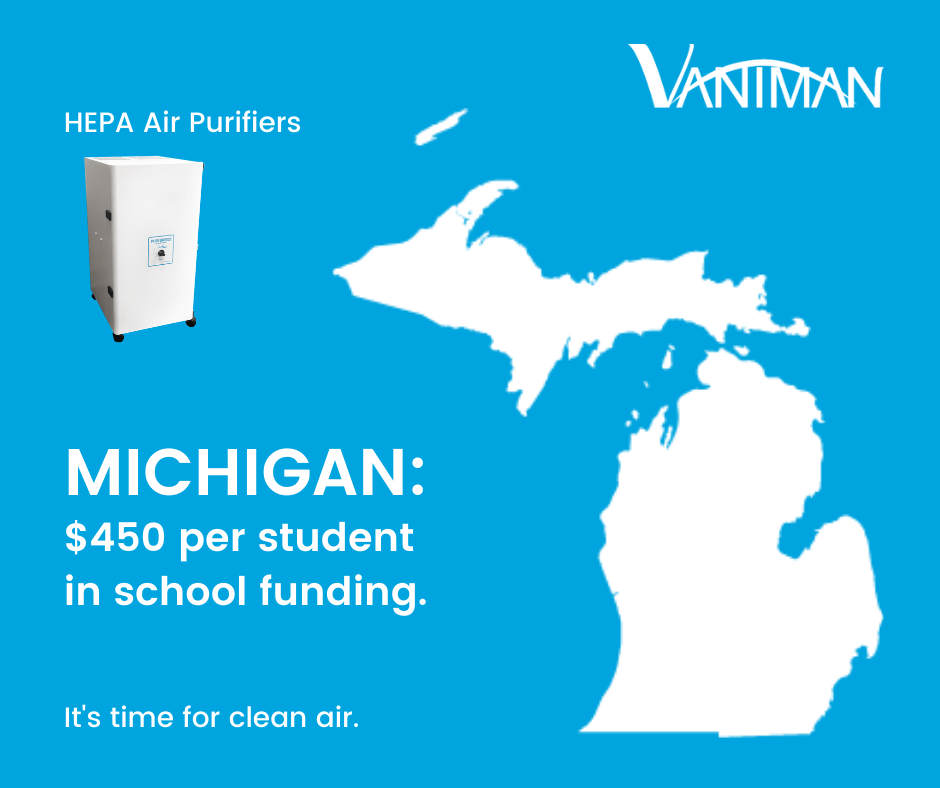
tl;dr: there is funding available for in-room HEPA air purifiers for Michigan Schools.
Good news out of the Midwest: the Great State of Michigan has passed a bill ensuring that each school district gets at least $450 per student for implementing COVID-19 related safety measures.
But that money only applies to schools currently offering 20 hours of in-school instruction per week.
There are exceptions and additional specifications – it’s all in the Enrolled House Bill No. 4048, if you want to read it. It’s available online here. You’ll find the relevant parts in Sec. 11r (4).
From this arises a bit of a conundrum: schools who were pressured to open without full safety must operate with limited safety measures in order to receive the funds to fully implement effective safety measures. Twists and turns are everywhere.
Scientific research tells us COVID-19 is airborne, and spreads primarily via biological aerosols. We also know that HEPA filtration can capture those aerosols. We also know that sufficient air exchange through a HEPA filter can capture those aerosols with 99.997% efficiency.
Airflow and air filtration really should be top of mind for school administrators.
What About HVAC?
If your school district has tried to upgrade the HVAC filtration system, that may have been a mistake.
That mistake usually comes in the form of complacency. Many schools have opted to simply install new filters. They may have been led to believe that a MERV-13 filter will take care of the problem. So no further effort gets made. After all, that seems quick, cheap and easy, and you’ve gotta get those students into those classrooms, right?
Not so fast. Installing a MERV-13 rated filter into the HVAC system is unlikely to produce the necessary number of filtered air exchanges to meet CDC-recommended safety measures.
Ask yourself: was this school’s HVAC system even designed for this kind of stress? Have you had your system assessed?
HVAC system assessments can take weeks. If you find you need to overhaul your entire HVAC system, that can take more weeks or even months. Certainly it will cost hundreds of thousands of dollars.
Instead of HVAC…
If your classes are already in session with minimal to no filtration upgrades, you’re in luck! The CDC also recommends in-room portable HEPA filtration devices.
Air purifiers (like the Vaniman Pure Breeze HEPA Air Purifier) are portable and fit easily into a classroom. They can be plugged in and activated immediately. There are no installation costs.
And these units can be purchased with those available funds. $450 per student is more than enough to purchase a unit for each classroom. Our air purifiers will improve classroom air quality dramatically without disrupting sessions due to excessive noise.
What to Watch Out For:
- CFM? Cubic feet per minute is a good metric for how powerful the unit is. If the in-room air purifier can’t move a lot of air, it can’t purify a lot of air. In a classroom setting, new aerosols enter the air constantly, and you need something that can achieve the CDC’s recommended clean air changes per hour.
- UV light? The CDC does not recommend air purifiers with UV light. Use of UV light to fight airborne viruses is not effective in rapid airflow (requires several seconds of exposure). They may even produce toxic ozone as a byproduct.
- Ionization? The CDC does not recommend air purifiers that offer ionization as a means of combating the spread of disease.
- Photo Electrochemical Oxidation (PECO)? The CDC does not recommend air purifiers that use PECO filtration as a means of combating the spread of disease.
- Wi-Fi connectivity? This is unhelpful and unnecessary as far as air quality goes.
- Energy use? Not all purifiers need to operate at full capacity 100% of the time; the best bet for selecting a purifier is to speak with the manufacturer about achieving air changes per hour in conjunction with the HVAC system and potentially opening windows. Our Pure Breeze offers three speeds for varying needs and energy uses.
- Noise level? The average human conversation is about 60 decibels (dB). Our Pure Breeze operates on highest setting at 56 dB.
- Availability? Not all bulk orders are created equal, and as we recently saw with the ship stuck in the Suez Canal, global supply chains are delicate. Orders from overseas may cause more headaches than they are worth. Our purifiers are assembled here in the USA and orders will come swiftly to all 50 states.
We urge you, as the CDC does, to consider in-room portable HEPA filtration units for COVID-19 safety. These purifiers are good for long-term air quality control in your schools as well.
And, of course, we urge you to specifically consider the Vaniman Pure Breeze HEPA Air Purifier.
Our portable air cleaner has a powerful enough motor to change the air in a standard sized room over six times per hour (as recommended by the CDC) and hums quieter than a typical human conversation. It’s an ideal device for the health and safety of students and teachers. We can ship units to school districts in a hurry. We recently shipped hundreds of units to New Mexico; before that we delivered to a district in Western Michigan.
Reach out to Vaniman today to see how you can take advantage of the $450 per student funding to get portable HEPA air purifiers into your classrooms!

Information Sources
State of Michigan, 101st Legislature, Regular Session of 2021: Enrolled House Bill no. 4048
Centers for Disease Control and Prevention (CDC): COVID-19 Guidelines for Ventilation in Buildings
UC San Diego News: UC San Diego Scientists Call on Biden Administration to Address Inhalation Exposure
